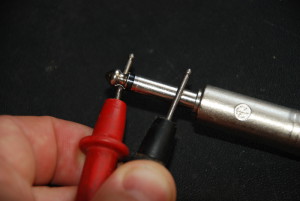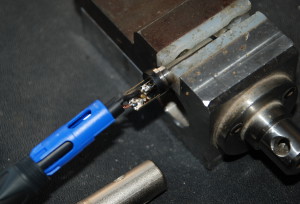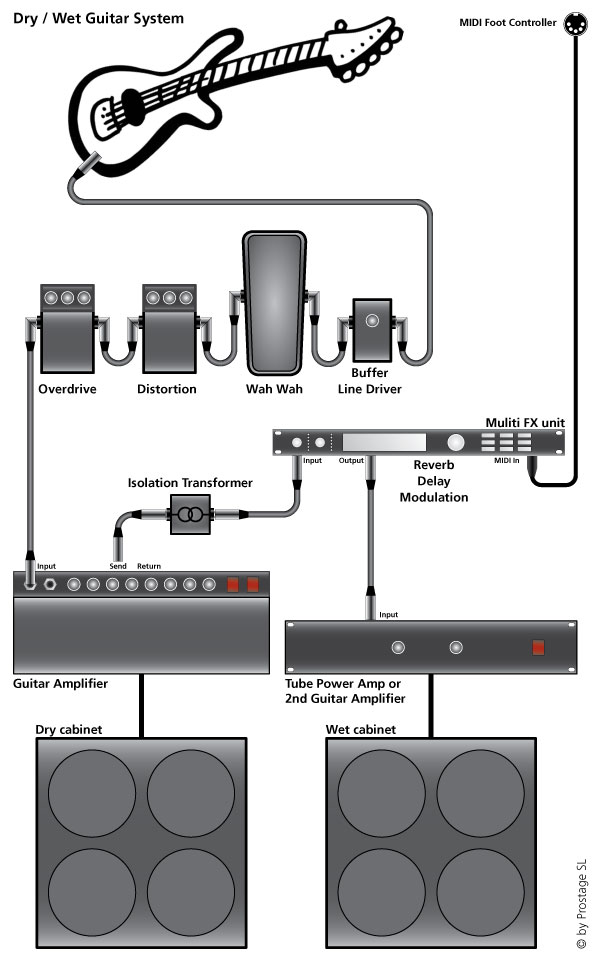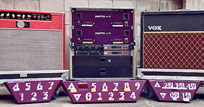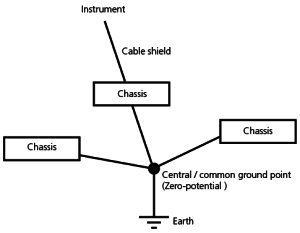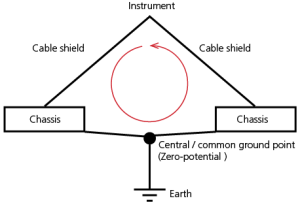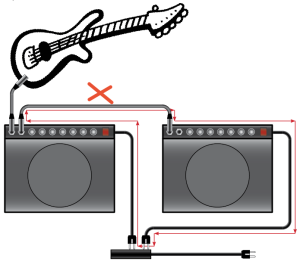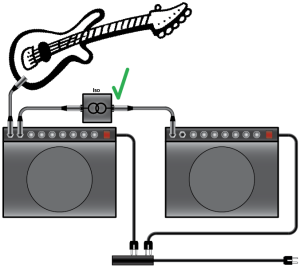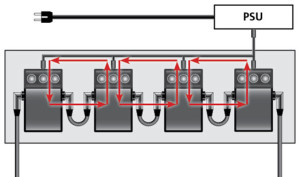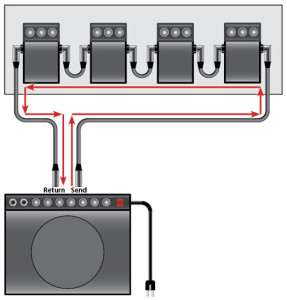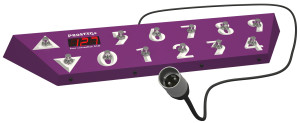Which is the proper power supply for my guitar effects? What is voltage, what is the difference between AC and DC, and why do I have to care about currency and polarity?
When a guitar effect does not work, probably the most likely reason for this is that you are using the wrong power supply. When powering guitar effects, the following four electrical characteristics must be taken into account: the required voltage (V), the required current (mA), AC or DC and the polarity (in case of DC). If several devices are fed with a common power supply, there is also the issue of galvanic isolation.
A correctly labeled unit indicates the following information on the enclosure:
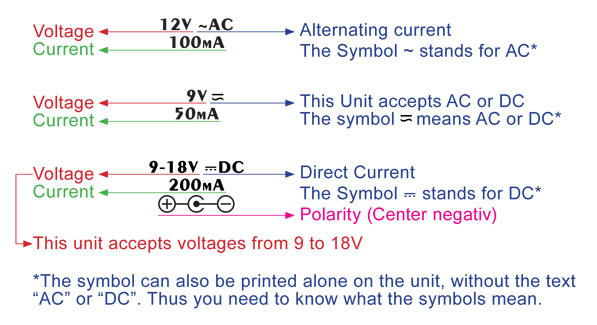
Guitar effects power supply labeling
Unfortunately, not all manufacturers label their devices properly. However, a look into the users manual would have to promote the missing data.
Voltage (V)
Voltage (mesured in Volt) is the electrical potential between two points. If we compare electricity to water, voltage is like the water pressure. The pressure is there, waiting for the valve to open, allowing the water to flow. In contrast to water, the voltage does not flow into the “empty”, but only from one electrical pole to the other. Thus, voltage can only exists across or between two points (poles).
=> If the voltage of the power supply is too low, the guitar effect cannot work because it doesn’t get enough energy from the power supply.
=> If the voltage is too high, the effect may blow up because it cannot handle the amount of energy.
=> Voltage (V) of a power supply must always match the voltage of the device to be powered.
Current (mA)
Current is the amount of electrons that flow from one pole to the other. As long as the two points are “open”, no electricity flows. As soon as we connect the guitar effect to the power supply (or as soon as we switch it on), the electricity starts to flow from one pole through the effect to the other pole.
Back to our water analogy, current is the amount of water that flows through a pipe. The “mA”-value stated for a guitar effect is the max. amount of current the unit needs to operate. The “mA”-value printed on a power supply (e.g. Voodoo Lab pedal power) is the max. amount of current the psu can supply.
The power supply must be able to supply at least as much power as the effect device needs. It does not hurt, however, if the power supply can supply more (this is even an advantage). The opposite is quite bad. If the effect device requires more power than the power supply can deliver, the power supply “goes to its knees”, the voltage is “torn”. A regulated power supply switches off when there is an overload. This can either occur immediately or in the middle of the gig. A simple (unregulated) power supply simply ends up in a puff of smoke.
Analogue devices typically require very little current (less than 20mA), while digital devices require much more (several 100mA).
=> If a power supply is not capable to deliver the required amount of current, the guitar effect cannot work because it doesn’t get enough energy. Further, it can damage the power supply because the effect pedal demands too much energy.
=> Current (mA) of a power supply must at least match or better exceed the requirements of the device which you like to power.
AC/DC (Alternate Current / Direct Current) & Polarity
AC/DC is not only one of the world’s most famous rock bands, it is more an important electrical characteristic. The current, thus the electrons that flow in a cable, have a direction. A light bulb does not care in which direction the electrons flow. But most electronic components work only in one direction.
Most guitar effects work with direct current (DC). DC has a positive (+) and a negative (-) pole. These devices thus specify in which direction the current must flow. Therefore, the correct polarity (plus & minus) must be observed here too. Those units only work with correct connected polarity.
But there are also some guitar effects which require an alternating current (AC) power supply. Alternating current means that the polarity changes with the mains frequency (50Hz in Europe, 60Hz in America). Thus, the polarity does not matter when using an AC power supply. Guitar effects powered by AC have an integrated rectifier which converts the AC power to the DC power required for internal operation. These integrated rectifiers have some benefits which would be too technical to be explained here.
=> Guitar effects that require DC must be powered with a DC power supply. Further, you have to take care about polarity.
=> An effect that requires AC must always be powered with an AC power supply. There are also a few units that can be powered with AC and DC alike.
=> Powering DC guitar effects with an AC power supply can immediately destroy the unit. Powering an AC effect with DC will result that the effect pedal is not working
=> Always connect the proper (AC or DC) power supply. If using DC, make sure to have the correct polarity
Multiple power supply
Usually you have several effects which have to be supplied with power. On the one hand there are power supplies with several outputs. On the other hand, you can also use a simple power distribution cable with multiple plugs, which allows several effects to be connected to a single power supply. But here you must pay attention too!
Multiplug Power Distributuion Cable (Daisy Chain Cable)
You can feed several effects with the same power supply. If you have, for example, a power supply that says “9V DC 500mA”, and you have three guitar effects, one that needs 250mA, one that needs 100mA and another that needs 50mA, you can power all three effects with the same power supply. All three effects together require 400mA, the power supply can deliver 500mA. So enough for all three effects. However, a multiple power cable (daisy chain cable) may only be used if the following conditions are ALL met:
- All guitar effects require the same voltage.
- All effects require Direct Current (DC).
- All effects have the same polarity.
- All the effects together need no more power than the power supply can deliver
- The effects are arranged directly behind each other in the signal path.
=> Effect devices that are supplied with alternating current require a separate power supply each.
=> If there is an effect device in front of the amp, and another in send / return, they need separate power supplies. Otherwise, you would build a ground loop over the power cable, which will result in hum.
Multi Output Power Supplies
If you are using a power supply with several outputs, make sure that the outputs are galvanically isolated. This is the same like having several independent power supplies in one housing. You can then easily operate one effect device on each connector.
If the outputs are not galvanically isolated, it is simply a single power supply with multiple parallel connection sockets. This is the same as using a daisy chain cable and brings the above mentioned limitations and problems with it.
Choosing the right guitar effects power supply
Recapitulation: We have a power supply (the wall adapter) and a load (the guitar effects pedal). The power supply must provide the rated voltage (e.g. 9V DC). The effects pedal draws whatever current it needs. As long as the power supply can provide the current required by the effect pedal, everyone is happy and everything works. Things get murky if the power source can’t maintain the current, or if the voltage is too high or too low.
Troubleshooting
If you are having trouble powering your guitar effects, double-check if the current and voltage requirements by the effects pedal and the power supply match. Run through these steps:
1. If your effect pedal shipped with a wall adapter ex-works, try powering with the original power supply. If it powers up, it’s probably an issue with your third-party power supply, respectively, the used power supply is not suitable.
2. Check whether the power supply is AC or DC. Under no circumstances connect an AC power supply to an effect which must be supplied with DC, and not vice versa. Most effects are supplied with DC.
3. Check the polarity (DC power supplies only). Most guitar effects have a 2.1mm power connector with “center-negative” polarity. This unofficial standard was introduced by Boss many years ago. A “normal” power supply therefore fits with a “normal” effect.
However, a few manufacturers do it exactly the other way round (“center positive”). Further, there are also other plugs, e.g. Mini-jack or 2.5mm. Be sure to read the manufacturer’s specifications, where the positive and where the negative pole is. The polarity is often indicated by a symbol on the effects pedal. Incorrect polarity can damage the unit irreparably.
4. Check the voltage. Some guitar effects are very specific about their voltage requirements. If the effect pedal requires 9V, be sure not to send it more than 9V, because excessive voltage can irreparably damage the device. On the other hand, some pedals are perfectly happy running at anywhere from 9V to 18V. Just be sure you know what the manufacturer recommends.
5. If you own a voltage meter, check if at the output of the power supply comes out what should come out, or if the device perhaps may be defective. Note: at an unregulated power supply, it is normal that the voltage reads 10-20% higher without a load connected.
6. Finaly, check the current. Make sure the power supply is capable of providing more current than the guitar effects pedal requires. For example, if your pedal requires 200 mA, it’s probably best to provide it at least 250 mA to ensure it works properly under all circumstances.
Now you’re a power genius and you know everything you need to know about powering your effects devices. For further information about building and wiring your guitar rig, get Prostage’s “Ultimate Guitar Rig Building Guide” with lots of tips & tricks how you prevent noise, hum and losses of transpareny & dynamics as well as lot of further valuable information.

